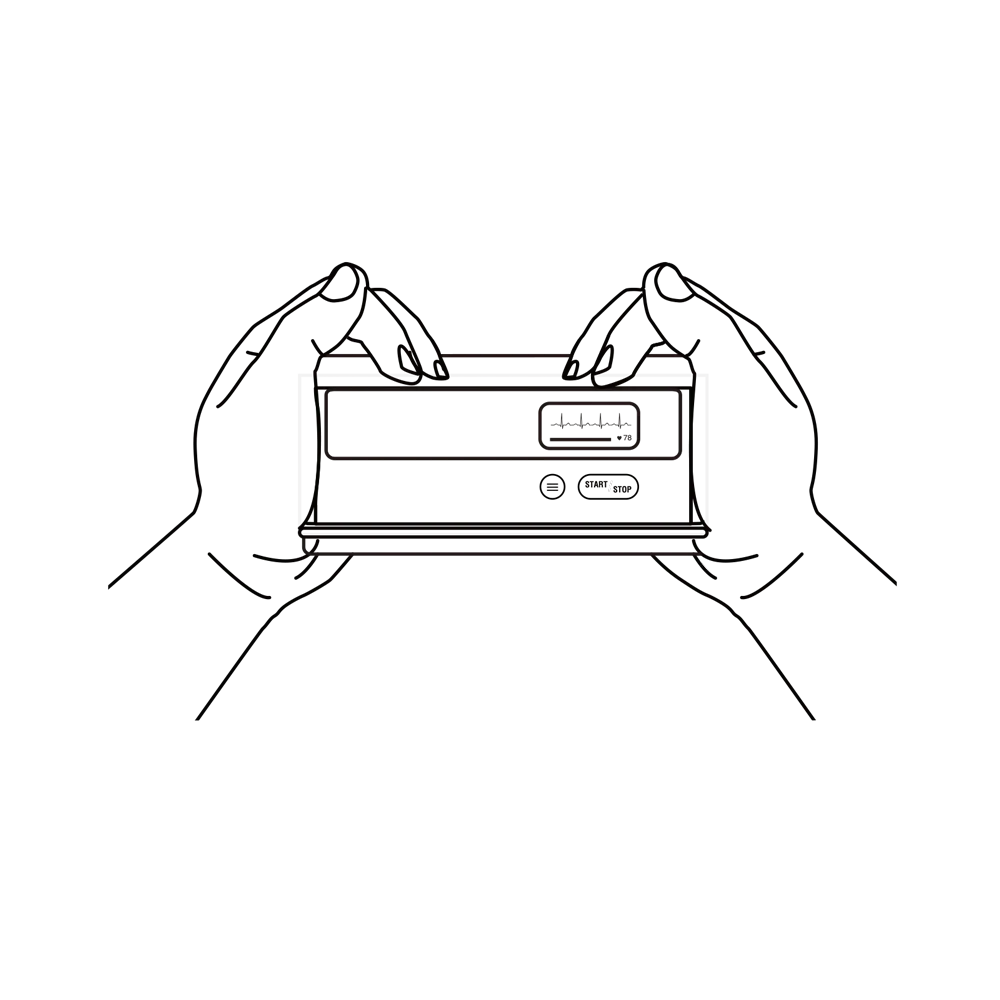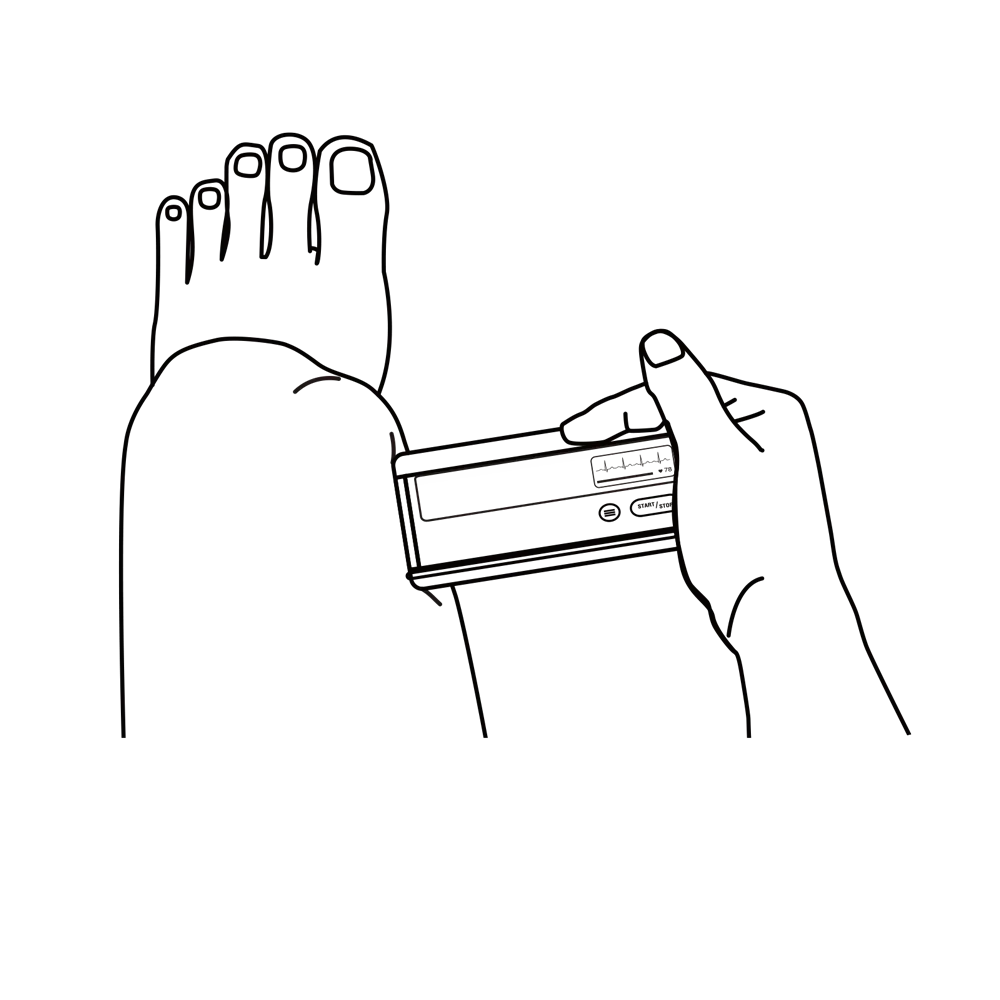Step 1: Wrap the cuff, 1-2 cm above the inside of theelbow;
Step 2: Sit and keep the cuff being level with your heart;
Step 3: A push on the button to launch the measurement.

Step 1: Wrap the cuff, 1-2 cm above the inside of theelbow;
Step 2: Sit and keep the cuff being level with your heart;
Step 3: A push on the button to launch the measurement.


Lead I: hand to hand

Lead II: right hand to left leg

Lead II: right hand to abdomen

Chest Lead: right hand to chest
What should I do if I get a high blood pressure reading?
A single high reading is not an immediate cause for alarm. If you get a reading that is higher than normal, wait 5 minutes and take your blood pressure a few more times. If your readings are still high, consult your doctor to verify if there’ s a health concern.
How do I pair my blood pressure monitor to a smart mobile phone?
Following the below directions:
1. Do not turn off the monitor after taking a measurement.
2. Launch the ViHealth App on your smart device.
3. The measuring data will be automatically synced when the monitor connects to the ViHealth App successfully.
Confirm the following:
1. Your smart device is a compatible device.
2. Your smart device is not in airplane mode.
3. The Bluetooth of your smart device is turned on.
4. The monitor is on the synchronized state. The current measuring data cannot be synced while monitoring.
5. The monitor and smart device are within 5 meters for Bluetooth communication.
6. Turning off the Bluetooth of your smart device, you may be able to sync after turning it on again.
7. You may be able to sync after restarting the monitor.
1. Turn on your monitor.
2. Launch the ViHealth App on your smart device.
3. The date and time on your monitor will automatically sync as your smart device settings when it connects to the ViHealth App successfully.
The monitor has built-in storage. It is not necessary to run the App.
You cannot delete the stored data manually. The stored data will be overwritten by the latest measuring data.
Try the following:
Sit in a relaxed position.
Clean the metal electrodes with water on a slightly damp paper towel.
Moisten the measuring position of your skin.
Body hair may affect the performance of the device. We recommend removing excess body hair.
Try other method (Lead II, chest lead or Lead I).
Try the following:
1. Sit in a relaxed position.
2. Clean the metal electrodes with water on a slightly damp paper towel.
3. Moisten the measuring position of your skin.
4. Body hair may affect the performance of the device. We recommend removing excess body hair.
5. Try other method (Lead II, chest lead or Lead I).
The monitor will automatically storage the data after taking an ECG recording. If you run real-time monitoring on the App, the data will be stored on your phone as well.
To record an ECG on your phone, following the below directions:
1. Turn on the monitor and run the ViHealth App.
2. After the App connect with the monitor successfully, select the [Dashboard] screen on the App.
3. Start to take an ECG recording on the monitor, and the ECG waveform will be displayed on the App simultaneously.
4. The recording will take 30 seconds, remain still while recording.
5. Then you can review the recorded data on the [ECG] screen on the App.
In the user manual that came with the monitor, there is a section included on on the different types of error messages. Please review this section of the manual. If this does not fully resolve the issue, please contact us (support@mdcubes.com).
Blood pressure is the measure of the force of blood pushing against blood vessel walls.
A blood pressure reading has a top number (systolic) and bottom number (diastolic). Systolic represents the pressure as your heart contracts to pump blood to your body. Diastolic represents the pressure between beats, when your heart relaxes.
Both pressure readings are important, they are necessary to enable a doctor to evaluate the status of a patient’s blood pressure.
High blood pressure, also called hypertension, is dangerous because it makes the heart work harder to pump blood out to the body and contributes to hardening of the arteries (atherosclerosis), stroke, kidney disease, and the development of heart failure.
For almost everyone the risks of high blood pressure affect you in the long term. So, the important thing is to make sure that you know what your blood pressure is and if it is high that you receive treatment and stick to it.
A blood pressure reading has a top number (systolic) and bottom number (diastolic). Normal blood pressure is less than 120 over 80 (120/80).
People whose blood pressure is above the normal range should ask their doctor how to lower it.
Blood pressure measurement values vary from the left arm to the right arm.
Several studies have been done to determine what is a normal variation between right and left arm. In general, any difference of 10 mm Hg or less is considered normal and is not a cause for concern.
Home blood pressure monitoring may be especially useful for:
1. Anyone diagnosed with high blood pressure (HBP or hypertension).
2. Individuals starting high blood pressure treatment to determine its effectiveness.
3. People requiring closer monitoring, especially individuals with risk factors for high blood pressure and/or conditions related to high blood pressure.
4. Pregnant women, experiencing pregnancy-induced hypertension.
5. Evaluating potentially false readings, like:
(1) People who only have high readings at the doctor’ s office (“white coat” hypertension).
(2) People who only have high readings at home but not at the doctor’ s office (“masked” hypertension).
Be still. Don't smoke, drink caffeinated beverages or exercise within 30 minutes before measuring your blood pressure. Empty your bladder and ensure at least 5 minutes of quiet rest before measurements.
Sit correctly. Sit with your back straight and supported (on a dining chair, rather than a sofa). Your feet should be flat on the floor and your legs should not be crossed. Your arm should be supported on a flat surface (such as a table) with the upper arm at heart level. Make sure the bottom of the cuff is placed directly above the bend of the elbow.
Measure at the same time every day. It’s important to take the readings at the same time each day, such as morning and evening. It is best to take the readings daily however ideally beginning 2 weeks after a change in treatment and during the week before your next appointment.
Take multiple readings and record the results. Each time you measure, take two or three readings one minute apart and record the results.
Don't take the measurement over clothes.
Following the below directions:
1. Make sure you have removed any tight-fitting clothing from your left arm.
2. Put your left arm through the cuff loop. The bottom of the cuff should be about one-half inch
above your elbow.
3. Turn your arm so your palm is facing up.
4. Adjust the cuff around your arm so that the tubing runs down the center of your arm.
5. Secure the cuff so it stays in place.